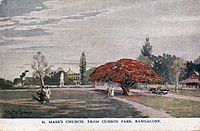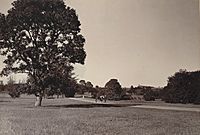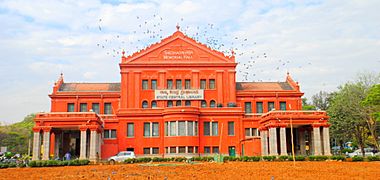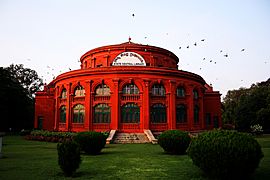Sri Chamarajendra Udyanavana facts for kids
Quick facts for kids
Sri Chamarajendra Udyanavana
Sri Chamarajendra Park
|
|
|---|---|
|
Neighbourhood
|
|
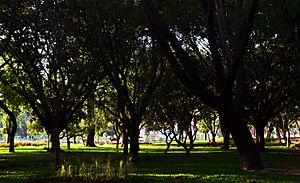 |
|
| Country | |
| State | Karnataka |
| District | Bengaluru Urban |
| Metro | Bengaluru |
| Founded | 1870 |
| Founded by | Sir John Meade |
| Named for | Maharaja Chamarajendra Wadiyar X |
| Government | |
| • Body | Department of Horticulture, Government of Karnataka |
| Area | |
| • Total | 1.2 km2 (0.5 sq mi) |
| Languages | |
| • Official | Kannada |
| Time zone | UTC+5:30 (IST) |
| Pin Code |
560001
|
| Website | http://www.horticulture.kar.nic.in/cubbon.htm |

Sri Chamarajendra Park, also known as Cubbon Park, is a very important green space in Bengaluru city. It's like the "lungs" of the city, helping to keep the air fresh. You can find it right in the middle of Bengaluru.
The park was first created in 1870 by Major General Richard Hieram Sankey. He was the British Chief Engineer of Mysore State at that time. It started as a 100-acre park. Over the years, it grew much bigger and is now about 300 acres.
This park has a long history. It is full of many different plants and animals. You can also find beautiful buildings and statues of famous people inside.
The park was first called Meade's Park in 1870, named after Sir John Meade. Later, it was renamed Cubbon Park after Sir Mark Cubbon, who was a commissioner for a very long time. In 1927, it was renamed again to Sri Chamarajendra Park. This was to honor Sri Chamarajendra Wodeyar, a ruler from the 1800s.
The park's design mixes natural rocks and thick groups of trees with open grassy areas and colorful flowerbeds. The Horticulture Department of the Government of Karnataka takes care of it. Many roads run through the park, and there are also nice walking paths. People love to walk here in the mornings. Tourists often call Bengaluru the 'Garden City' because of parks like this one.
Contents
Getting to Cubbon Park
You can easily reach Cubbon Park from several main roads. These include M.G. Road, Kasturba Road, Hudson Circle, and Ambedkar Veedhi (Road). Only light vehicles are allowed on the roads inside the park.
All parts of the park are easy to reach using the walking paths. The park is always open to the public. However, the roads inside are closed to traffic from 5:00 AM to 8:00 AM every day. This makes it safer and quieter for people who come for morning walks and exercise. The park roads are also closed to traffic all day on Sundays.
Amazing Plants in the Park
Cubbon Park is home to many different types of plants and trees. There are about 6,000 plants and trees from 68 different groups. Some plants are native to India, like artocarpus, cassia fistula, ficus, and polyalthias.
You can also find many plants from other countries. These include araucaria, bamboo, castanospermum australe, grevillea robusta, millettia, peltophorum, schinus molle, swietenia mahagoni, and tabebuia.
Beautiful Tree Avenues
The park has many beautiful tree-lined paths, called avenues.
- One path has araucaria trees and canna flowers. It goes from the Central Public Library to Hudson Circle.
- Another path has Swieteninas trees on the north side.
- The Java fig avenue leads to the Government Museum.
- A polyalthia avenue connects the Queen Victoria's statue to King Edward VII's statue.
- There's also a chestnut tree avenue from the Chamarajendra statue to Siddalingaiah circle.
These avenues show how rich the park is in plants. Other nice spots in the park include the Ringwood circle, a lotus pond, and a bamboo grove.
Historic Buildings and Statues
Cubbon Park is not just about nature; it also has many important historical buildings and statues. The formal gardens start from the main hall of the old Attara Kacheri building. This building is now the Karnataka High Court. The gardens stretch out in a straight line with tree-lined paths leading to the museum.
Another impressive building is the Iyer Hall. It houses the Central Library and has a lovely rose garden in front. This library is the biggest public library in Karnataka. Many college students come here to study. It also has a huge collection of Braille books for visually impaired people.
Other buildings in or near the park include:
- The Indira Priyadarshini Children's Library
- The Venkatappa Art Gallery
- The Aquarium (said to be the second largest in India)
- The YMCA
- Yuvanika — the State Youth Centre
- Century Club
- Press Club
- Jawahar Bal Bhavan
- Tennis Pavilion
- The Cheshire Dyer Memorial Hall
- The Ottawa Chatter
-
Inauguration of the statue of Sir Mark Cubbon, Bengaluru India. Illustrated London News, 5 May 1866
There is also an octagonal bandstand made of cast-iron. It was built in the early 1900s. Before India became independent, the British Royal Air Force used to play music here every Saturday evening.
For children, there's a fun amusement park called Jawahar Bal Bhavan. It has a toy train called Puttani Express that goes around the park for 1.2 kilometers. There's also a Doll museum and a place for boating. You can even see a 20-million-year-old fossilized tree in the park! It was a gift from the Geological Survey of India.
You will find several marble statues in the park. These honor important figures like Queen Victoria (from 1906), King Edward VII (from 1919), Major General Sir Mark Cubbon, Sri Chamarajendra Wodeyar (from 1927), and Sir K. Sheshadri Iyer (from 1913). They are placed in front of the historical buildings.
Attara Kacheri: The High Court Building

The Attara Kacheri building was built in 1864 during British rule. It is a striking two-story stone building with a deep red color. It features Corinthian columns and a Gothic style. You can find it right at the entrance to Cubbon Park.
From 1868 to 1956, this building housed government offices. Later, these offices moved to the Vidhana Soudha, which is across the street. Today, the building is home to the Karnataka High Court. Inside the main hall, there is a portrait of Sir Mark Cubbon on the ceiling. An equestrian (horseback) statue of Cubbon is located behind the building.
The Government Museum
The State Archeological Museum is one of the oldest museums in India. It was built in 1876 by Colonel Sankey. Its design and red color are similar to the Attara Kacheri.
The museum displays ancient items, some from as far back as the Mohenjo-daro period. You can see examples of Vijaynagara and Halebid architecture. There are also old coins and stone carvings that are up to 5,000 years old.
Seshadri Iyer Memorial Hall: The Library
The Seshadri Iyer Memorial Hall was built in 1915. It honors Sir K. Seshadri Iyer, who was a chief minister of Mysore State from 1883 to 1901. This impressive red building has a classic European style with Tuscan and Corinthian columns.
It houses the Seshadri Memorial Library. The building is surrounded by the park's greenery and has a rose garden in front. This library is the main public library for the state of Karnataka. In 2000, it won an award for being the best state central library in India. It was recognized for its great work in spreading knowledge. The library currently has 2.65 lakh (265,000) books and a special section for Braille books.
Protecting the Park
The Government of Karnataka passed the Preservation Act in 1979 to protect Cubbon Park. This law makes sure that no new buildings are allowed in Cubbon Park or Lalbagh. The only new constructions allowed are those built by the Horticulture Department to help the park. This act helps keep the park unique and green.
Learning About the Environment
In 2006, the Centre for Environment Education (CEE) in India started a project. They created a brochure about Cubbon Park. They also encouraged young people to explore the park and learn about the environment. This brochure was a joint effort between CEE and the Department of Horticulture.
Remembering Mark Cubbon
After India gained independence in 1947, many people started to forget the contributions of British administrators like Mark Cubbon. However, over time, more people began to recognize his important work.
On August 23, 2013, for the first time since 1947, the statue of Mark Cubbon was honored with garlands. This was done by Advocate S Umesh from the Cubbon Park Walkers’ Association. It was to celebrate Sir Mark Cubbon's 238th birthday. Special permission was needed from the Karnataka High Court. The group believes Mark Cubbon was one of the main people who helped build Bengaluru and Mysuru.
Even though Cubbon Park was officially renamed Sri Chamarajendra Park in 1927, most people still call it Cubbon Park. Historians say it's important not to erase history. Trying to remove all signs of British rule might not lead to real progress.
On June 28, 2020, the equestrian statue of Mark Cubbon was moved from the Karnataka High Court grounds into the park itself.
Images for kids
Location in Context
 |
Vikasa Soudha | Vidhana Soudha/Dr Ambedkar Road | Karnataka High Court |  |
| Palace Road | M. Chinnaswamy Stadium/Queen's Road | |||
| Reserve Bank of India | Sree Kanteerava Stadium/Kasturba Road | Vittal Mallya Road |
See also
 In Spanish: Parque Cubbon para niños
In Spanish: Parque Cubbon para niños



